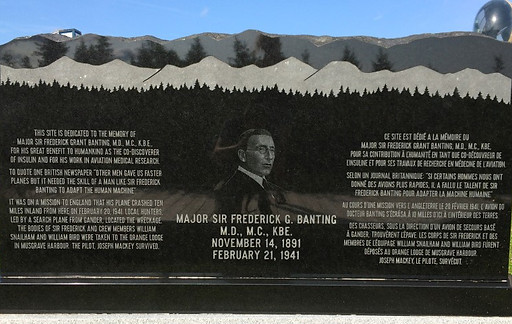Death of a Hero: Sir Frederick Banting's Plane Crash
Banting Memorial Municipal Park, Musgrave Harbour
Plane crash wreckage is always an emotional and moving site to see. While every crash brings with it a sad and unfaithful tale, in February, 1941 one plane crash claimed the life of a truly astonishing hero. Sir Frederick Grant Banting was on his way to London to the demonstration of a revolutionary flight suit he helped design, when his plane began experiencing engine trouble and crashed near Musgrave Harbour. Banting managed to survive the crash only to succumb to his injuries in the unforgiving Newfoundland backcountry.

Who was Sir Frederick Banting?
Banting was born on November 14, 1891, in Alliston, Ontario and completed his first year of post-secondary education at the University of Toronto. After failing his first year he switched into medicine and soon thrived before graduating with above-average grades in 1916.
After this, he immediately enrolled in the military and the following March was sent to Britain as Lieutenant Banting. After a year of serving his country in France, he was promoted to Captain and began serving in the France No. 3 Canadian General Hospital as a Battalion Medical Officer. In the summer of 1918 Banting transferred to the 13th Canadian Field Ambulance near Arras in Northern France. On September 18 Banting was awarded the Military Cross for his bravery on the battlefield when he was injured attending wounded soldiers. In February 1919 Banting returned home to Canada where he worked in Toronto before officially leaving the military in the summer of 1919.
Banting then moved to Toronto where he worked at the Hospital for Sick Children in Toronto for a number of months before starting his own practice in London, Ontario. In 1920 he became a part-time teaching assistant in Physiology at the University of Western Ontario and on October 31, 1920, was said to awaken with an idea of how to isolate insulin after spending time reading medical articles about the pancreas. Over the following year, Banting and John James Rickard Macleod researched isolating insulin before successfully isolating the hormone on September 27, 1921. This revolutionized the untreatable disease, diabetes and would go on to save a countless number of lives.

Banting began testing his theories on dogs and saw quick improvement to their health after a few injections of insulin (from their own pancreas) per day. The pancreas of the dogs could not produce enough insulin to sustainably be a viable option. So Banting and Macleod began using cow and pig pancreases to extract insulin (a method which would continue until the late 20th century).
In 1922 he opened his own private practice and a Diabetic Clinic at the Christie Street Hospital for Veterans where he began treating patients with diabetes. As of result of this astonishing discovery, on October 25, 1923, Banting and Macleod were awarded a Nobel Prize in Medicine making Banting the first Canadian recipient of the prize. The Government of Canada granted him with a lifetime income to continue his work and in 1934 he was knighted by King
George V.

Banting continued to remain with the military reserves during all of this and when war broke out in 1939 he offered his assistance to serve his country in Europe once again. Thus he rejoined the Royal Canadian Army Medical Corps.
The Crash
In 1941 Banting had planned to travel to London to the demonstration of a revolutionary flying suit he helped design that would stop pilots from passing out while completing high-speed maneuvers. On February 20th Banting took off from Gander in a Lockheed Hudson Bomber. Shortly after takeoff, the plane began experiencing engine trouble and crash landed 16 kilometers south of Musgrave Harbour. While the operator and navigator died on impact, Banting and his pilot J.C. Mackey survived the crash. Banting suffered serious injuries in the crash and died the following morning after rescue failed to reach them in time.
On March 4, 1941, Banting was buried at Mount Pleasant Cemetery in Toronto with full military honours.

Sources & Further Exploring
Bliss, M. (1982). The Discovery of Insulin. London: Macmillan Press.
Hume, S.E. (2001). Frederick Banting: Hero, Healer, Artist. Montréal, QC: XYZ Publishing.
Sir Frederick Banting. The Canadian Forces Medical Service website found at www.cdnmedhall.org.

